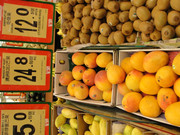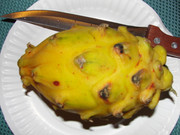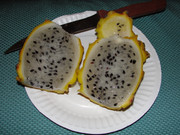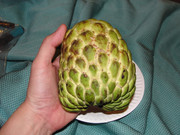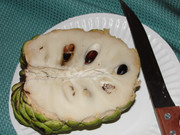Hello everyone,
I picked my first home grown mango about two weeks ago. The mango is a Nam Doc Mai from a grafted tree and it was grown in Southern California. I've had the tree for about three years and removed the fruit each year when they are thumb size but this one fruit was hidden behind a leaf so I didn't even notice it until it was half grown.
The fruit was picked about two weeks ago mature green with just a hint of yellow blush on one side. It was hard as a rock when I picked it. I let it sit on the counter for about 5 days but it was still hard so I set it on my seedling heat mat for another 5 days and it got just slightly soft. I then put it in the fridge for one night and finally cut it open last night.
There was just a slight sweet smell coming from the fruit but you had to pick up the fruit and sniff it up close to smell it. The fruit weighed slightly over 12 ounces and had an extremely thin seed. I harvested the fruit mature green because there was rain in the forecast two weeks ago and I was afraid of the fruit splitting. I believed the fruit would ripen properly because I read that a slight yellow blush is an indicator that the fruit may be ripe. The fruit also had filled in shoulders.
When I cut the fruit open, it was a golden yellow orange color and I was glad to see there was no jelly seed nor black streaks in the flesh. There was absolutely no fiber and this mango was extremely sweet! I mean it was really really sweet. There was no "tropical mango" flavor that I associate with Haden, Kent and Edward mangoes. Not wanting to waste any of the flesh, I skinned the mango as close to the skin as I could get but I left little bit of green skin on the flesh which may be the reason a couple bites had a slight green taste to it. This mango was sweeter than any Champaign, ataulfo, manilla or Kent mango I've had all year. The flavor had hints of honey and the rest was pretty much pure sweetness. The NDM mangoes I had in Thailand had more floral bouquet and didn't have any of that green flavor. Next time I will leave the fruit on a little longer and also remove all of the green skin.
The seed was paper thin except where the embryo was. The embryo was very small and appears to have two parts/seedling. I gave this tree some organic 0-10-10 after I discovered it was hiding a fruit and I believe this is partially why the fruit was so sweet. I believe the Potassium helps sweeten up the fruit.
I am extremely glad I planted this tree because I absolutely love this fruit. I still can't believe such a small tree with so few leaves can bring a mango to maturity and full sweetness. The tree is only about two feet tall and has very few leaves. The thing I don't like about this tree is that it is extremely dwarf and flowers constantly, producing very few leaf flushes. I have tried very few varieties of mangoes but based on the fiberless and extremely sweet flesh of this NDM, it is one of the best mangoes I've ever eaten. Right up there with the Edwards mango off Eunice's tree.
Simon

















